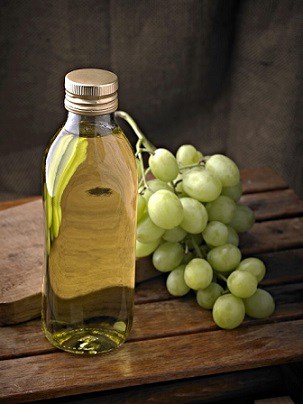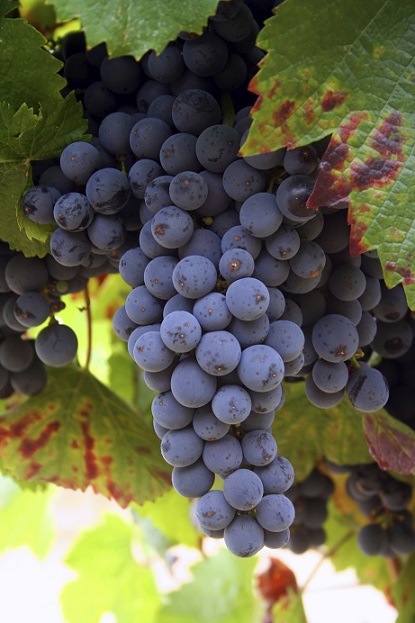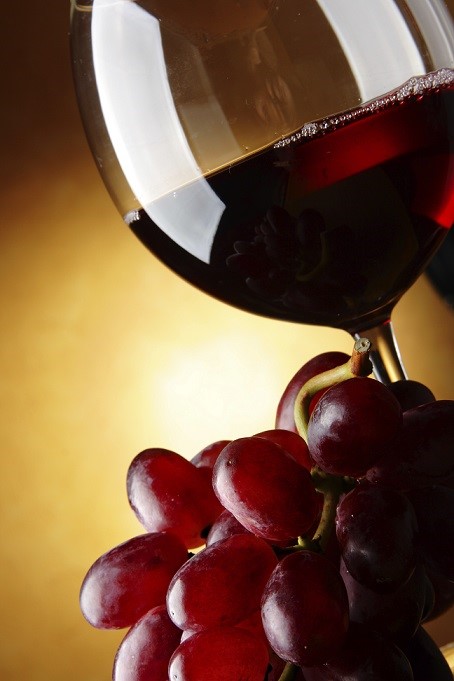If you’re only just getting into natural skincare remedies, then the cures for acne may be far more commonplace than you realise.
For example, a single cup of fully ripe strawberries contains 97% of the RDI for vitamin C, which calms stress and speeds up the healing of old acne by increasing collagen formation. Strawberries are teeming with thousands of obscure plant phytonutrients, with one example being the anti-inflammatory flavanol quercetin. Finally, strawberries are an antioxidant bombshell which create a natural inbuilt armour against sunlight and air pollution.
You can obtain each of these benefits by simply eating a tasty piece of fruit. You don’t have to throw away hours every month with a chemical regimen that ultimately gets you nowhere.
Topical treatments are fantastic bonus weapons, but diet should always be your top priority. One of the better examples for acne is the common grocery store grape.
Grapes – weak at first glance
Firstly, 100 grams of the common grape contains just 18% of the RDI for vitamin C. Compare that to 97% in strawberries, 79% in pineapples, and 43% in raspberries; almost every other fruit contains more.
18% doesn’t sound terrible, but for acne-clearing purposes, the RDI of 60mg is far too low already. I recommend at least 200mg daily.
Elsewhere, 100 grams of both red and green grapes contains…
- Vitamin C – 18% of RDA.
- Magnesium – 2%.
- Vitamin A – 1%.
- Calcium – 1%.
- Iron – 2%.
- Vitamin B6 – 4%.
- Vitamin E – 1%.
- Vitamin B12 – 0%.
- Manganese – 4%.
- Selenium – 0%.
- Potassium – 5%.
- Vitamin D – 0%.
- Zinc – 0%.
- Vitamin K1 – 18%.
Grapes are a non-factor for the classic acne nutrients like vitamin E, vitamin A and zinc. For antioxidants, they’re better though not incredible. Red grapes score 1837 on the ORAC scale, while green grapes score 1018. That’s a good score, but almost all berries are superior, including strawberries (4302), raspberries (5065), blackberries (5905), blueberries (4996), and cranberries (9090).
Grapes have a variety of acne-clearing powers
Overall, grapes look weak for acne on the surface. But the basic nutrition is deceptive, as where they really shine is in calming chronic inflammation, the number 1 internal cause of acne.
This 2012 study fed 46 grams of grape powder, equivalent to 252 grams of whole grapes, to a group of humans. 4 weeks later, their anti-inflammatory markers such as interleukin-10 and adiponectin had rocketed upwards.
Read Annihilate Your Acne – learn how to clear your skin permanently
This 2014 study, meanwhile, fed grape powder to people with kidney disease. A placebo group suffered from high c-reactive protein, the classic pro-inflammatory biomarker, but the humble grape managed to eliminate this increase. The scientists concluded that “grape powder as phenolic source could play an important role as an anti-inflammatory agent“. This study, this study, and this study observed reductions in inflammation from grape marc, grape powder extract, and whole grapes respectively.
Next up, it’s the antioxidants’ time to shine. The ORAC scores of 1837 and 1018 are decent, but the actual studies dramatically outperform them:
ONE – this human study observed that grape juice protected against cancer and defended DNA strands from damage. Lowering free radicals was deemed to be responsible.
TWO – this 2009 study observed a 71% increase in liver levels of the master antioxidant glutathione (learn why it’s vital for acne here).
THREE – after drinking some grape juice, 21 humans experienced noticeable increases in total bloodstream antioxidants, showing that “consuming moderate amounts of daily grape juice may favourably affect antioxidant defense systems” (study).
FOUR – in the livers of rabbits, grape skin powder increased glutathione while decreasing lipid peroxides, the deadliest form of free radical for acne (study).
FIVE – 50 cardiovascular patients were fed red grape powder (study), and after 12 weeks, their blood lipid peroxides and overall oxidative stress fell “significantly“.
The meaning for acne is simple, but very important. Increasing antioxidants prevents the sebum on your skin from oxidising and becoming doubly potent at clogging your pores. Less free radicals/oxidative stress means that less bodily antioxidants will be depleted.
Meanwhile, it’s often said that humans are only 10% human, that we have 10 trillion human cells and 100 trillion bacteria cells, many of which reside in our gut. Families like Lactobacillus spend all day churning out anti-inflammatory molecules like butyrate, but other species are downright sinister.
H.pylori, for example, is specifically linked to acne, via the dark arts of food allergies and leaky gut syndrome. In this promising study, grapes wiped out the h.pylori bacteria with ease, and interestingly, the muscadine grape subspecies performed particularly strongly.
Grapes also have a fantastic sunlight protection study, where its antioxidants brought the formation of free radicals in the epidermis (the skin’s outer layer) to a near total halt. The main UV protector was identified as gallic acid, an antioxidant which red grapes are especially rich in. While the grapes were applied topically this time, many antioxidants such as beta-carotene are known to migrate to your face when eaten.
Grapes can end oily skin via insulin control?
 Finally, we have a study hinting at oily skin powers, conducted on 66,105 women and 36,173 men.
Finally, we have a study hinting at oily skin powers, conducted on 66,105 women and 36,173 men.
Among the 14 fruits tested, grapes and raisins were tied second for preventing type 2 diabetes when eaten at least thrice weekly. They were defeated only by blueberries, and demolished tons of theoretically healthier fruits, including oranges, strawberries, and apples. Plums, prunes, peaches and apricots were all inferior to grapes.
The connection to acne is surprisingly simple, as type 2 diabetes is the inevitable endgame of crippled insulin sensitivity and out of control insulin levels. Insulin is the most important oily skin hormone bar none, so this study is a great proxy for acne.
What’s particularly interesting is that strawberries were significantly inferior to grapes, despite containing far more antioxidants. Grapes must have a unique unidentified property, or a unique composition of specific phytonutrients.
Raisins, nothing more than dried grapes, performed just as strongly, so the stellar results weren’t a fluke. This study and this study again noticed promising powers for insulin and blood sugar control.
Grapes contain a bonus resveratrol helping
Resveratrol is a phytoalexin compound manufactured in the grape’s skin, designed to ward off fungi and insects. Over approximately the last ten years, countless newspaper headlines have insisted that “red wine holds the key to long life”, or ordered you to “take resveratrol and live to age 150”.
Normally, you should always be sceptical about media hype, but this time, they have a point. In studies, resveratrol activates an anti-aging gene known as SIRT-3, which kickstarts the mitochondrial energy source of human cells, the same gene that calorie restriction extends human lifespan by activating. Resveratrol in copious amounts of red wine is also why the French live so long and enjoy good heart health (possibly).
As for acne, resveratrol is a potent antioxidant itself, supposedly several times more potent than vitamin C. But even better, resveratrol increases your body’s production of its own antioxidants too, namely superoxide dismutase.
The best study of all time compared a placebo cream to a resveratrol cream, applied to each symmetrical side of an acne patient’s face. After 60 days, the placebo side barely changed, with a non-significant 6% drop. But resveratrol lowered total pimple counts by a massive 54%. Luckily, the evidence suggests that resveratrol’s benefits are replicated when eating it.
Resveratrol is most strongly associated with red wine, but the red grapes it’s derived from contain decent amounts too. 100 grams boasts around 0.15mg, while green grapes contain significantly less at 0.02mg.
Why aloe vera is the nemesis of red and inflamed acne
Actually, grapes aren’t the richest fruit for resveratrol at all. At 0.35mg, strawberries contain significantly more, cementing their status as the ultimate acne fruit. Many of the best studies used high concentration resveratrol as well, meaning that the quantities in grapes won’t be as amazing.
But given the positive studies above, the resveratrol is a great bonus indeed (full article on resveratrol here). Most resveratrol is concentrated in the grape’s skins, along with 95% of the total antioxidants.
Any downsides for acne?
The biggest flaw with grapes is their relatively high sugar quantities. Both red and green contain 15 grams per 100 grams, alongside a small fibre count of 0.9 grams. All fruits contain some sugar, but fibre absorbs and slows its digestion, minimising the inflammation and formation of AGEs (advanced glycation end products – a type of free radical).
Nevertheless, if you craft a diet with one high, one medium, and two low sugar fruit slots, the acne-clearing benefits of grapes can easily be yours to behold. One daily system could be a serving of red grapes (high sugar), an apple (10 grams), and a handful each of strawberries (4.9 grams) and raspberries (4.4 grams).
Grapes are also a member of the high FODMAP fruit club. If you’re sensitive to FODMAPs (more on these natural allergens here), then grapes could easily trigger a massive outbreak…
…but if you’re not sensitive, then sugar is pretty much the only problem (apart from pesticides).
The strategy – red vs green
If you want to use grapes to clear your acne naturally, then there’s only one logical choice.
While the basic nutrients like vitamin C and E are virtually identical, red grapes contain 5 times more resveratrol, with 0.15mg to the green grape’s 0.02mg. In fact, antioxidants are the main difference overall. The red grape has an ORAC score of 1837 compared to 1018 for green grapes. Here’s the breakdown for known individual antioxidants (undiscovered ones could also exist).
Catechin – 1.41mg in green, 5.46mg in red.
Epicatechin – 0.49mg in green, 5.24mg in red.
Epigallocatechin – greens have 0.02mg, reds have 0.03mg.
Resveratrol – green (0.02mg), red (0.15mg).
Procyanidin dimer B1 – 0.64mg (green), 0.43mg (red).
PCD B2 – 0.06mg (green), 0.36mg (red).
PCD B3 – 0.20mg (green), 0.12mg (red).
PCD B4 – 0.38mg (green), 0.33mg (red).
Epicatechin 3-0 gallate – 0.25mg (green), red (1.68mg).
Trans-resveratrol – 0.03mg (green), 0.15mg (red).
Caffeoyl tartaric acid – 2.74mg (green), 1.14mg (red).
Quercetin 3-O glucuronide – 1.50mg (green), 2.15mg (red).
Procyanidin trimer C1 – 0.07mg (green), 0.38mg (red).
P-coumaroyl tartaric acid – 1.00mg (green), 0.56mg (red).
Green grapes win the war for 5 antioxidant varieties, but overall, red is the clear winner with 9.
The explanation is equally interesting, as the dark colour of red grapes is derived from a gene encoding anthocyanin production, one of the most potent classes of antioxidants. Anthocyanins are designed to attract insects to pollinate, and to keep infections at bay, but also to attract mammals such as us to eat them and spread the seeds (which we have now successfully bred away).
Green grapes, meanwhile, carry this gene, but it lies dormant due to mutations. The plant’s fruit stays green, and possesses less antioxidants overall. You can see that by observing wild grapes, which have to survive independently without the protection of farmers.
Read Annihilate Your Acne – learn why nuts can both cause and clear acne
Almost every wild species in the modern world is purple, red or blue. The Ancient Egyptians and Greeks created the modern wine industry 5000 years ago, and their favoured variety of grapes was said to be purple.
So remember: if you ever stumble across an obscure subspecies of grape in the wild (there’s thousands across every continent except Antarctica), a darker colour is always superior.
Avoid hyper-sweet versions!
Whatever you do, do not pick the cotton candy grape. This is the latest phenomenon in fruit, the candy fruit.
Essentially, some farmers are giving up the fight in persuading the public to adopt a healthy diet. They’ve adopted an “if you can’t beat ’em, join ’em” strategy and used all their talents to breed a new subspecies of grape loaded with so much sugar that it tastes like candy floss.
This quote comes from somebody who sampled one: “the taste triggers the unmistakable sensation of eating a puffy, pink ball of spun sugar“. When asked why they did this, the agricultural company claimed that they have to compete with candy bars and cookies.
Don’t get tempted by these 21st century tricks! If you notice that the grape you’re eating tastes like candy floss, then throw it in the bin. Your goal is simple: maximise the nutrient intake while minimising the inevitable sugar. Reject cotton candy grapes at all costs.
Another inferior variety you should reject is the Thompson seedless grape. This subspecies wasn’t born through agriculture; it was actually a Persian mutant discovered 1000 years ago in the wild. The problem? The same seed-removing mutation also destroyed its anthocyanins and resveratrol production.
Are organic grapes necessary?
Unlike bananas or pineapple, grapes are one conventional fruit where the pesticide count is so high that everyone should avoid it.
Why? It’s the same reason as strawberries, blueberries and spinach. Grapes are small, and more surface area equals more room for pesticides. That’s why the wine industry accounts for 3.7% of France’s agricultural land, but utilises 20 percent of its pesticide expenditure. One of the most common grape pesticides, cryolite, is actually based on fluoride. Back in 1988 there were even union-led boycotts and hunger strikes in protests against chemical-ridden grape farming in California.
Nowadays, the harshest pesticides are banned, but grapes are still a fixture in the Environmental Working Group’s dirty dozen list of pesticide-drenched crops – in 2016 they ranked sixth.
What’s more, new villains have surfaced, and one of the worst is glyphosate, an herbicide commonly applied to GMO corn and soybeans. Grape farmers don’t spray glyphosate directly onto grapes, but rather into the soil below to wipe out weeds. The plant absorbs the chemicals in the soil with ease, and it does end up in the fruit…
Why grapeseed oil could transform your skin
…and consequently, a recent study found that 100% of conventional Californian wines contain glyphosate residue. Glyphosate is now classed as a level 2A “probable carcinogen” by the World Health Organisation, and as for acne, small levels can devastate your acne-friendly gut bacteria. Organic wines contained 14 times less.
Luckily, organic grapes are pretty cheap, at least here in England. Some claim that organic produce is drenched in pesticides anyway and that it’s all a big lucrative scam. However, this myth was disproved in a recent study on 99 Mediterranean vineyards; the conventional grapes all had detectable pesticide residue, whereas in organic grapes they were undetectable.
Organic grapes may even have higher levels of resveratrol, because sensing mould directly stimulates the skins to increase their resveratrol defences. When fungicides are applied, this stimulation is ended.
If you do lack the money, then pick fruits which are members of the clean fifteen, such as pineapple or sweet potatoes.
Conclusion
Wihle grapes lack a standout gimmick for acne, they can lower inflammation, increase antioxidant supplies, and possibly improve oily skin via controlling insulin.
Grapes rank somewhere below pomegranates, strawberries and raspberries, but above melons and pears. What’s certain is that any fruit is far better for your acne than cakes, cookies, or donuts. Even the cheapest green grape grown in the most nutritionally deprived wasteland won’t give you soy, corn, a massive dose of sugar (unless it’s the cotton candy grape), or omega 6s from canola oil.
Never believe that benzoyl peroxide and Accutane are the only solutions to your acne.
NEXT: forget creams and moisturisers – discover the ultimate acne-clearing diet
Thanks for reading!



Hi, I know you mentioned raisins briefly in the article, but what are your thoughts on raisins vs grapes overall? Where I live I can’t find any organic grapes at all (they only have non-organic), but I can get organic raisins in the health food shops. I was thinking of adding a tablespoon of raisins to my morning smoothy. Is it still worth getting non-organic red grapes and washing them well prior to eating? Nice website by the way – I discovered it a couple of weeks ago!
Thanks Nivek – unfortunately raisins are significantly worse for acne due to being dried out and highly concentrated in sugar. They’re marketed as a health food but 100 grams contains approximately 60 grams of sugar, so they’re actually nothing of the sort. In fact raisins are probably one of the fakest “health foods” out there. You’d do better to choose a fruit where organic is unnecessary like pineapple or another organic fruit altogether (because grapes are the tip of the iceberg).
Hi Richard, thanks for all the informative articles. I’ve put some quite some of your advice into practice the last couple of months. I’ve been eating a lot of vegetables and fruit, adding cinamon to my food, avoid products with added sugar, eating brazil nuts and taking vitamine D and Zinc supplements. So far my outbreaks are decreasing a lot! Especially the cystic acne and overall inflamation. My skin however still gets greasy. Do you have suggestions what to try next? Thanks so much in advance. Kind regards, M.
Good to hear it, you might like this article for ending the oily skin. https://supernaturalacnetreatment.com/8-scientifically-proven-solutions-to-oily-skin-and-hence-acne/
Sebum production is one factor that’s strongly under genetic control, so you may never be able to control it fully, but everybody has some room to manoeuvre.